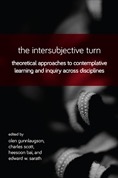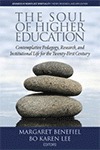contemplative pedagogy
Select an item by clicking its checkbox
Date Reviewed: April 15, 2020
Contemplative pedagogy has become quite popular over the past decade (Jacoby, 2019). This book builds on previous contemplative pedagogical scholarship (Barbezat and Bush, Contemplative Practices in Higher Education, Jossey-Bass, 2014; Simmer-Brown & Grace, Meditation and the Classroom, SUNY Press, 2011), especially a prior volume by the same editors—Contemplative Learning and Inquiry across Disciplines (Gunnlaugson et al., 2014). This book focuses on second-person perspectives or intersubjectivity, which the editors note can be represented spatially as between people, rather than subjectively inside or objectively outside them. It seeks to redress the tendency in contemplative studies to focus on first-person, personal experiences or third-person, objective study and observation of individuals engaged in contemplation.
The Intersubjective Turn would interest contemplative studies scholars as well as instructors with a previous background in contemplative pedagogy. Those unfamiliar with contemplative approaches to higher education would benefit from first consulting the work of Barbezat and Bush (Contemplative Practices in Higher Education, Jossey-Bass, 2014) or the previous volume (Gunnlaugson et al., Contemplative Learning and Inquiry across Disciplines, 2014), especially Arthur Zajonc’s overview of contemplative pedagogy in higher education and Harold Roth’s proposed pedagogy for contemplative studies. Although instructors who teach in public universities and colleges may find it challenging to adapt some of the contemplative approaches to their institutional context, those at private institutions and seminaries may encounter less difficulty in applying the contemplative pedagogies discussed.
Each article emphasizes the value of incorporating intersubjectivity into one’s contemplative pedagogy and focuses on particular classroom activities that promote such intersubjectivity. Mirabai Bush discusses her “Just Like Me” exercise developed for Google’s Search Inside Yourself program, where participants first engage in self-compassion and then become aware of what they share with others, and her “Mindful Emailing” activity where participants write a response to an email, but before sending it, lean back, take three deep breaths, re-read their response and imagine how it might be received by the other person. David Lee Keiser describes a pedagogical practice that addresses students’ discomfort at being stared at: a “stage exercise” where students mindfully walk to the front of the auditorium, pause and take a breath, make eye contact at least once with everyone in the room, then mindfully walk off stage, taking another breath and then returning to their seat.
Lyn Hartley advocates deep dialogue in which students explore uncertainties and questions that no one has answers to, which allows for transformative learning. Judith Simmer-Brown draws on Gregory Kramer’s method of “insight dialogue” to have students sit in dyads, reflecting on challenging aspects of their spiritual or personal journeys as they speak for three minutes and then return to silence and deep listening.
David Forbes uses mindfulness as a way for students to reflect on unexamined assumptions and conditioned patterns of thought in order to move towards a postconventional, self-authorized consciousness that tolerates ambiguity and agile thinking. Joanne Gozawa emphasizes the value of students not only doing contemplative practices, but “not doing” them by listening to silence and embodying a posture of receptivity. Other chapters discuss theological and theoretical reasons for engaging in intersubjective contemplative practices, advocating contemplative inquiry as a means of promoting empathetic connection.
Date Reviewed: June 21, 2021
My teacher training focused on goals and assessment. When I conduct workshops on teaching and whenever I am asked for advice on teaching, I tell instructors to clarify goals and work backward. Two years ago I gave a presentation on technology in the classroom. I included a laundry list of ...

Contemplative Practices in Higher Education: Powerful Methods to Transform Teaching and Learning
Date Reviewed: November 30, -0001
We live and teach in a world of massive distraction. It is difficult to find spaces or times in which people are simply still, let alone inhabit silence. College students claim they are effective “multi-taskers” but more and more research is suggesting that multitasking is not a route to deep learning, and can even begin to shape attention practices in detrimental ways. What can we do? One generative inquiry into these challenges comes from the field of contemplative practice. What is contemplative practice? The authors of this book define it broadly, noting that these practices
certainly include meditation, but not all are meditative in the traditional sense. . . . They all place the student in the center of his or her learning so that the student can connect his or her inner world to the outer world. Through this connection, teaching and learning is transformed into something personally meaningful yet connected to the world. (6)
Bookended by a foreword written by Parker Palmer, and an afterword by Arthur Zajonc, this book is a much needed and pragmatic resource for anyone teaching in a higher education context. It is based on nearly twenty years of research into contemplative practices in higher education, including the work of 152 fellows who worked on classroom experiments in more than one hundred colleges and universities. Barbezat and Bush provide a concise but thorough overview of this research, while keeping their focus on teaching and learning practice.
The book is divided into two sections, the first concentrating on theoretical and pedagogical background, the second a guide to contemplative practices in higher education classrooms. Issues such as neuroplasticity, the challenges of reflecting on first-person experience, and a range of theoretical resources for introducing and developing meditation and introspection are explored in the first section. In the second section the authors draw from a vast array of pedagogical experiments in a diverse assortment of disciplines to resource specific exercises in mindful reading, writing, listening, movement, and action. These resources include specific writing prompts, examples of syllabi, and a rich collection of bibliographic entries for further study.
The authors also address directly the challenge of the religious studies classroom: “The most problematic place in the academy to introduce contemplative practices has been religion departments, where the concern has been that a professor who practices the religion he or she is teaching would not be sufficiently objective. Teaching contemplative practices to students raises a further concern: proselytizing” (105). Here the authors are quick to point out that contemplative practices of this sort are about “students discover[ing] their own internal reactions without having to adopt any ideology or specific belief” (6).
But is this really an appropriate response? My primary critique of this significant book is to ask what it means to invite students into a “technology” of embodied practice without at the same time inviting them to inhabit the beliefs within which that technology arose. Are we really willing to remove context in this way? Or is the contextual collapse we are already living within (cf. Michael Wesch) necessarily confronted by the intentionally attentive work of contemplation? Can practices of meditation and introspection so ground our knowing as to build the kind of insight, compassion, and systemic analysis necessary for living in a deeply present way in our postmodern world?
There are likely no clear or single answers to these epistemological conundrums. As one of the teachers whose work is explored in the book, Mary Rose O’Reilly, writes: “I learned that the single most important thing a contemplatively centered classroom teaches the teacher is not a pedagogical recipe but pedagogical flexibility” (188).
For my part, I am hopeful and energized by the various experiments with which these innovative educators are engaged. Given that education must, at heart, “create environments for students to inquire and challenge themselves about the meaning of their lives and the lives of others” (200), this book offers both rich reflection and pragmatic resources for doing so.

The Pursuit of Wisdom and Happiness in Education: Historical Sources and Contemplative Practices
Date Reviewed: April 8, 2015
Steel includes in this work both recommendations and critiques that follow from his conviction that educators can and should take up the study of philosophy in their classrooms, which in this discussion is K-12. Using a foundation of classical Greek philosophy, the author takes up five themes in the book: (1) a survey of current ideas about how the pursuit of wisdom is or is not part of education; (2) a retrieval of ancient and medieval ideas of wisdom and the search for wisdom; (3) a critical examination of educational trends and practices and the barriers they create to the pursuit of wisdom; (4) use of ancient and medieval thought to assess current educational movements that aspire to promote wisdom; (5) a survey of movements understood as contemplative pedagogies and some cautions about their limitations. Finally, he indicates his own proposal for this project.
Steel critiques current educational practice along lines that many readers will find familiar: emphasis on assessment, stress on global competition, and pursuit of technological expertise without concern for ultimate ends. All of these, he argues, have not only been mistaken for the ideal goals of education, they militate against the real goal – the pursuit of wisdom. Steel prescribes these as essential for the attainment of wisdom: schole (leisure) leading to theoria (seeing) the ultimate good through the experience of metaxy (an experience of tension as one reaches from ignorance toward the Supreme Good, ultimate truth, or being as such). Taking from Plato the movement of ascent and descent as essential to reaching toward wisdom, he emphasizes the necessity of “dying to self and all that is not wisdom” (4). Steel is thorough in explaining his viewpoint in relationship to a host of educational greats: Augustine, Aquinas, Maimonides, Pieper, and Bloom, to name but a few.
The author states clearly that the pursuit of wisdom in a classroom today is likely to create serious negative pushback from the whole educational establishment. He believes this because he is convinced that only awareness of one’s ignorance makes wisdom possible. Such an experience of ignorance, he argues, is sure to be deeply uncomfortable and even intolerable for today’s students who are trained to attain the “right” answer above all. Such a practice is also contrary, he finds, to the mandate given teachers to produce students who can pass the required assessments. For the most part Steel leaves it to the reader to navigate a second potential problem, the fact that an educational institution may not necessarily agree that assisting students to reach toward the Supreme Good (or some other ultimate) is part of their educational mandate – or is even permissible.
Steel acknowledges that philosophical programs and contemplative pedagogical movements that aspire to facilitate student encounters with wisdom are present. Many of these, he argues, do not reach their essential goal because they are used as a means to some end other than wisdom: health, relaxation, or happiness, for example. According to Steel, “contemplative activity is not a tool for happiness; it is happiness, for it is the highest activity of the best part of the soul in relation to its most sublime object in the Supreme Good” (259). His own programmatic proposal is extremely brief as a proportion of this substantial book and chiefly cites his own experience in teaching Greek philosophy to high school students and using more modern texts such as Walden to encourage a contemplative experience of the world.
This volume will be appreciated by those interested in the intensive application of classic Greek philosophy to current educational practice and to a critique of current contemplative pedagogical movements.


